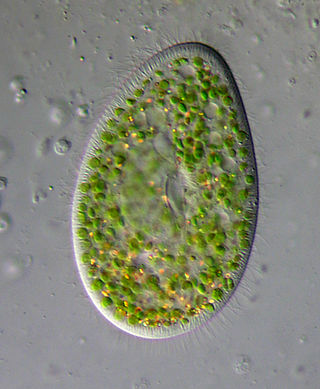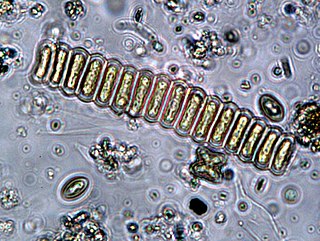
Paramecium bursaria is a species of ciliate found in marine and brackish waters. It has a mutualistic endosymbiotic relationship with green algae called Zoochlorella. About 700 Chlorella cells live inside the protist's cytoplasm and provide it with food, while the Paramecium provides the algae with movement and protection. P. bursaria is 80-150 μm long, with a wide oral groove, two contractile vacuoles, and a single micronucleus as well as a single macronucleus. P. bursaria is the only species of Paramecium that forms symbiotic relationships with algae, and it is often used in biology classrooms both as an example of a protozoan and also as an example of symbiosis.
Phycodnaviridae is a family of large (100–560 kb) double-stranded DNA viruses that infect marine or freshwater eukaryotic algae. Viruses within this family have a similar morphology, with an icosahedral capsid. As of 2014, there were 33 species in this family, divided among 6 genera. This family belongs to a super-group of large viruses known as nucleocytoplasmic large DNA viruses. Evidence was published in 2014 suggesting that specific strains of Phycodnaviridae might infect humans rather than just algal species, as was previously believed. Most genera under this family enter the host cell by cell receptor endocytosis and replicate in the nucleus. Phycodnaviridae play important ecological roles by regulating the growth and productivity of their algal hosts. Algal species such Heterosigma akashiwo and the genus Chrysochromulina can form dense blooms which can be damaging to fisheries, resulting in losses in the aquaculture industry. Heterosigma akashiwo virus (HaV) has been suggested for use as a microbial agent to prevent the recurrence of toxic red tides produced by this algal species. Phycodnaviridae cause death and lysis of freshwater and marine algal species, liberating organic carbon, nitrogen and phosphorus into the water, providing nutrients for the microbial loop.

Scenedesmus is a genus of green algae, in the class Chlorophyceae. They are colonial and non-motile. They are one of the most common components of phytoplankton in freshwater habitats worldwide.
Auxenochlorella protothecoides, formerly known as Chlorella protothecoides, is a facultative heterotrophic green alga in the family Chlorellaceae. It is known for its potential application in biofuel production. It was first characterized as a distinct algal species in 1965, and has since been regarded as a separate genus from Chlorella due its need for thiamine for growth. Auxenochlorella species have been found in a wide variety of environments from acidic volcanic soil in Italy to the sap of poplar trees in the forests of Germany. Its use in industrial processes has been studied, as the high lipid content of the alga during heterotrophic growth is promising for biodiesel; its use in wastewater treatment has been investigated, as well.

Choricystis is a genus of green algae in the class Trebouxiophyceae, considered a characteristic picophytoplankton in freshwater ecosystems. Choricystis, especially the type species Choricystis minor, has been proposed as an effective source of fatty acids for biofuels. Choricystis algacultures have been shown to survive on wastewater. In particular, Choricystis has been proposed as a biological water treatment system for industrial waste produced by the processing of dairy goods.
C. vulgaris may refer to:

Nannochloropsis is a genus of algae comprising six known species. The genus in the current taxonomic classification was first termed by Hibberd (1981). The species have mostly been known from the marine environment but also occur in fresh and brackish water. All of the species are small, nonmotile spheres which do not express any distinct morphological features that can be distinguished by either light or electron microscopy. The characterisation is mostly done by rbcL gene and 18S rRNA sequence analysis.

Climacostomum is a genus of unicellular ciliates, belonging to the class Heterotrichea.
Raphidocelis subcapitata, formerly known as Selenastrum capricornutum and Pseudokirchneriella subcapitata is a microalga. This microalga presents a curved and twisted appearance like a sickle. The cells are normally presented in a solitary form in culture, although it may also be present in small colonies. It has a length between 7 and 15 μm, and a width between 1.2 and 3 μm. A single chloroplast is present, filling nearly the entire cell; it lacks a pyrenoid. It is commonly used as a bioindicator species to assess the levels of nutrients or toxic substances in fresh water environments. This species is quite sensitive to the presence of toxic substances including metals and has a ubiquitous distribution, so is broadly used in ecotoxicology. This species has been found to be more competitive than Chlorella vulgaris at low sodium chloride concentrations, but C. vulgaris was more competitive under salt stress.

Chlorella autotrophica, or Chlorella sp. (580), is a species of euryhaline, unicellular microalga in the Division Chlorophyta. It is found in brackish waters and was first isolated in 1956 by Ralph A. Lewin. The species is defined by its inability to use organic carbon as a food source, making the species an obligate autotroph. It is sometimes considered a variety of Chlorella vulgaris.
Acanthocystis turfacea chlorella virus 1 (ATCV-1), also called Chlorovirus ATCV-1 or Chlorella virus ATCV-1 is a species of giant double-stranded DNA virus in the genus Chlorovirus.

Chlorella sorokiniana is a species of freshwater green microalga in the Division Chlorophyta. It has a characteristic emerald-green color and pleasant grass odor. Its cells divide rapidly to produce four new cells every 17 to 24 hours. The alga was described by Martinus W. Beijerinck in 1890. In 1951, the Rockefeller Foundation in collaboration with the Japanese Government and Hiroshi Tamiya developed the technology to grow, harvest and process Chlorella sorokiniana on a large, economically feasible scale. This microalga has also been used extensively as a model system to study enzymes involved in higher plant metabolism.
Chlorella volutis is a species of euryhaline, unicellular microalga in the Division Chlorophyta. It is spherical to oval-shaped, is solitary and lacks a mucilaginous envelope.
Chlorella rotunda is a euryhaline, unicellular microalga in the Division Chlorophyta. It is spherical to oval-shaped, is solitary and lacks a mucilaginous envelope.
Chlorella lewinii is a euryhaline, unicellular microalga in the Division Chlorophyta. It is spherical to oval-shaped, is solitary and lacks a mucilaginous envelope.
Chlorella singularis is a species of euryhaline, unicellular microalgae. It is spherical to oval-shaped and is solitary.
Chlorella pulchelloides is a species of euryhaline, unicellular microalga in the Division Chlorophyta. It is spherical to oval-shaped and is solitary
Chlorella coloniales is a euryhaline, unicellular microalga in the Division Chlorophyta. It is spherical to oval-shaped and is solitary
Phycotechnology refers to the technological applications of algae, both microalgae and macroalgae.

Chlorella vulgaris is a species of green microalga in the division Chlorophyta. It is mainly used as a dietary supplement or protein-rich food additive in Japan.







